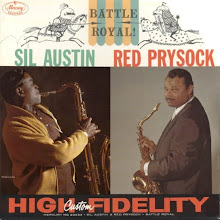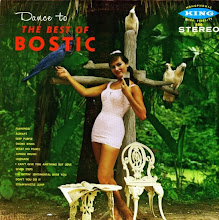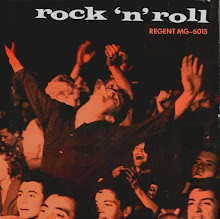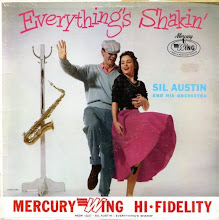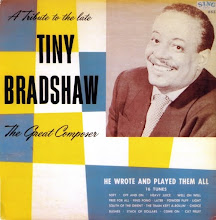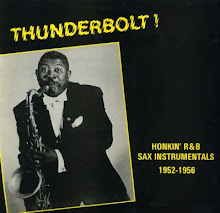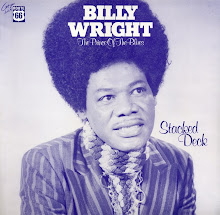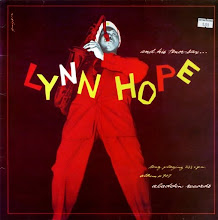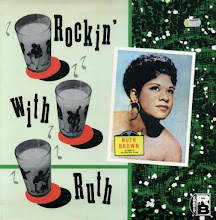Side 1:
1. Apollo Jump
2. Ride, Red, Ride
3. That's All!
4. Shipyard Social Function
5. Hurry, Hurry!
6. Shout, Sister, Shout!
7. Mason Flyer
8. Slide, Mr Trombone
9. There's Good Blues Tonight
Side 2:
1. Let Me Off Uptown
2. Rock Me
3. Little John Special
4. Who Threw The Whiskey In The Well?
5. Trouble In Mind
6. Big Fat Mama
7. Rock Daniel
8. All The Time
9. I Want A Tall Skinny Papa
They say that the real swing that was generated in live performance by the Lucky Millinder Orchestra was never captured on their recordings and that you really had to be there in a packed ballroom to appreciate just how good they actually were. Well there are plenty of tracks throughout this superfine 1983 Affinity LP which get my toes a-tappin’ so this band must have really been something else live.
Lucky Millinder couldn’t play an instrument or even read a music sheet, if we are to believe some accounts. What made him a great bandleader was his ability to choose performers and arrangers who could bring his musical dreams to reality. A dazzling parade of future R&B and jazz stars came through the ranks of this band, especially during the years they recorded for Decca (1941 – 47), the period of the recordings on this selection.
Here’s a sample of the instrumental talent on these tracks: Bill Doggett, Panama Francis, Tab Smith, Bull Moose Jackson, Stafford Simon, Sir Charles Thompson, Dizzy Gillespie, Sam “The Man” Taylor, Eddie “Lockjaw” Davis, Clyde Hart and Preston Love.
Vocal numbers were an important feature in Millinder’s live set and his recordings. In 1941 the band had Trevor Bacon and the remarkable Sister Rosetta Tharpe at the mic. The good Sister was a gospel singer and guitarist who for a time was not averse to performing more worldly material. She left the band in 1942 to perform at Café Society before finally giving up the sinful blues in order to devote herself to The Lord’s music. All of her tracks on this LP are superb. A mixture of the sacred and the not exactly profane. Check her out on YouTube to see some incredible performances with Lucky Millinder in the 1940’s through to television broadcasts from the 1960’s.
Trevor Bacon was a guitarist with a pleasant, if limited singing voice who could handle blues and ballads. His biggest hits with the band, “When The Lights Go On Again (All Over The World)” and “Sweet Slumber” aren’t on this collection, but “Big Fat Mama” and “Let Me Off Uptown” are fine swinging showcases for his vocal ability. In 1944 he left the Millinder outfit to hook up with a “breakaway” group led by Tab Smith. See the Be Bop Wino post
“I Don’t Want To Play In The Kitchen” for more of the Tab Smith / Trevor Bacon story.
After the departure of Bacon, Millinder picked up
Wynonie Harris as a replacement, and it’s hard to think of a greater contrast in voices. Wynonie’s powerhouse blues shouting is a world away from Bacon’s light voiced singing. “Who Threw The Whiskey In The Well?” was a number one R&B hit in 1945, by which time Wynonie had already disappeared over the horizon in search of solo glory.

His replacement came from within the ranks of the band – tenor sax man Benjamin “Bull Moose” Jackson stepping forward to take up vocal duties. Unfortunately his singing doesn’t feature on this collection. He fronted a series of recordings on the Queen and King labels which were really Millinder band performances issued under a different name to get round the Decca contract. See the Be Bop Wino post
“Big Fat Mamas Are Back In Style Again” for more Bull Moose.
Annisteen Allen recorded with the Millinder band between 1945 and 1951. Her only performance on this LP is “There’s Good Blues Tonight” which is a kind of precursor to “Good Rockin’ Tonight.” Other notable recordings by this fine singer include “Let It Roll” and “In The Middle Of The Night” but you’ll have to look elsewhere to find them, my swinging friends.
There’s a fair sprinkling of good instrumental numbers in this collection. “Mason Flyer” and “Little John Special” are most often cited by jazz critics as the best Millinder recordings. Both have solos by trumpeter Dizzy Gillespie, alto sax man Tab Smith and tenor sax player Stafford “Pazuzza” Simon. The propulsive “Apollo Jump” has a riff which Chuck Higgins fans will find oddly familiar.
Lucky Millinder himself was an occasional vocalist (“Shorty’s Got To Go”) with the one example here being “Ride Red Ride” which is a hangover from his days fronting the Mills Blue Rhythm Band back in the 1930’s. The Millinder Orchestra switched to RCA Victor in 1949 (“D Natural Blues”) and finally got to record officially for King between 1950 and 1952, including a reunion with Wynonie Harris for a great cover of Louis Prima’s “Oh Babe!” and a tremendous "Night Train." The break up came around that time, although Millinder did come out of musical semi retirement to front one last King session in 1955. See the Be Bop Wino post
“Ram-Bunk-Shush” for Lucky Millinder’s 1950's King recordings.

Ripped from vinyl at 320 kbps. Password = greaseyspoon
Download from here:
http://www84.zippyshare.com/v/tPXqnNYV/file.html
1. Apollo Jump
2. Ride, Red, Ride (vocal – Lucky Millinder)
3. That's All! ((vocal – Sister Rosetta Tharpe + band)
4. Shipyard Social Function
5. Hurry, Hurry! (vocal – Wynonie Harris)
6. Shout, Sister, Shout! (vocal – Sister Rosetta Tharpe)
7. Mason Flyer
8. Slide, Mr Trombone (vocal – Trevor Bacon)
9. There's Good Blues Tonight (vocal – Anisteen Allen)
10. Let Me Off Uptown (vocal – Trevor Bacon)
11. Rock Me (vocal – Sister Rosetta Tharpe)
12. Little John Special
13. Who Threw The Whiskey Down The Well (vocal – Wynonie Harris)
14. Trouble In Mind (vocal – Sister Rosetta Tharpe)
15. Big Fat Mama (vocal – Trevor Bacon)
16. Rock Daniel (vocal – Sister Rosetta Tharpe + band)
17. All The Time (vocal – The Lucky Seven)
18. I Want A Tall Skinny Papa (vocal – Sister Rosetta Tharpe + band)
Recommended purchase:

“Jukebox Hits 1942-1951” on the Acrobat label (has it been revived?) is available both as a CD and mp3 collection on Amazon. It has 20 tracks including 2 under Bull Moose Jackson’s name. Recordings from Decca, RCA and King, including many not on the LP posted here. Go git it! The world needs to swing more.





 His replacement came from within the ranks of the band – tenor sax man Benjamin “Bull Moose” Jackson stepping forward to take up vocal duties. Unfortunately his singing doesn’t feature on this collection. He fronted a series of recordings on the Queen and King labels which were really Millinder band performances issued under a different name to get round the Decca contract. See the Be Bop Wino post
His replacement came from within the ranks of the band – tenor sax man Benjamin “Bull Moose” Jackson stepping forward to take up vocal duties. Unfortunately his singing doesn’t feature on this collection. He fronted a series of recordings on the Queen and King labels which were really Millinder band performances issued under a different name to get round the Decca contract. See the Be Bop Wino post 
 “Jukebox Hits 1942-1951” on the Acrobat label (has it been revived?) is available both as a CD and mp3 collection on Amazon. It has 20 tracks including 2 under Bull Moose Jackson’s name. Recordings from Decca, RCA and King, including many not on the LP posted here. Go git it! The world needs to swing more.
“Jukebox Hits 1942-1951” on the Acrobat label (has it been revived?) is available both as a CD and mp3 collection on Amazon. It has 20 tracks including 2 under Bull Moose Jackson’s name. Recordings from Decca, RCA and King, including many not on the LP posted here. Go git it! The world needs to swing more. 







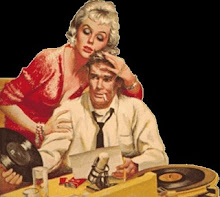


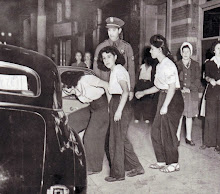



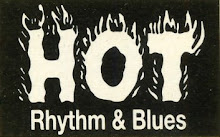
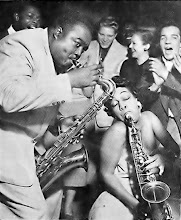





.jpg)


%2045%20-%201119B.png)














